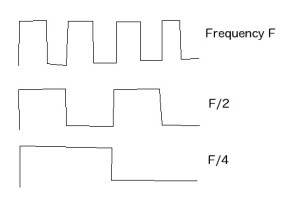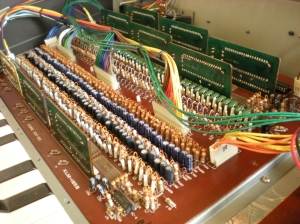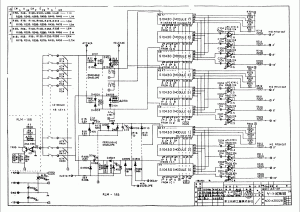The Korg Lambda in detail: Dividing and Keying
In my previous two posts I have given a brief overview of the Lambda’s architecture, and a more detailed explanation of its method of generating top octave pulse waves. What happens next?
Our top octave needs to be turned into a note for each key, and one that only sounds when that key is played. This is a multi-stage process consisting of dividing, keying and mixing.
*
Dividing
The first step is to divide down those 12 frequencies. Put simply, the constantly-running top octave is transformed into a set of keyed (that is, keypress-activated) outputs, each output here containing all the played notes of one octave.
The top octave waves are fed into a set of Divider/Keyer ICs. The IC used is the S10430. This, in a nutshell, takes these top octave waves and divides them down to cover the full keyboard. It also takes an input from each key on the keyboard that governs the level of the output of its own note. It then mixes the signals together and has outputs for each of the 2′, 4′, 8′, and 16′ pitches.
Study of the S10430 datasheet shows that the Lambda uses most but not all of the S10430’s capability: it can handle six frequencies per IC, whereas the Lambda employs it to handle four. There are nine S10430s in the Lambda – three for each oscillator, each handling four notes of the 12 from that oscillator’s TOG.
As has been mentioned in my Lambda overview, divide-down technology is a basic way of obtaining a full keyboard of notes. Once a waveform has been generated for each of the 12 notes of a scale, it is a simple matter to electronically halve that frequency to generate the same note one octave below, and then to halve that, and then halve that, and so forth. Various methods can be employed (for example, flip-flops or counters), but the result remains the same: after dividing down, there exists a square wave of the appropriate frequency for each note on the keyboard. In the Lambda, this operation happens within the S10430 divider/keyer IC. The S10430’s N-inputs take the TOG outputs, four to each module.
Below is a rough sketch of what a divided pulse wave looks like. Apologies for the roughness, I have no mastery of drawing software…
*
Keying
Left at only this, we would be faced with a constant blare of square waves at every pitch. What is needed is a way to pass those waves into the audio chain only when the appropriate keys on the keyboard are played. This is where the S10430’s keyer circuits come in.
The S10430 has a number of K-inputs. Each of these inputs takes a varying voltage from one key on the keyboard. The voltage present on that input governs the signal level of that frequency that is passed through to the outputs. Thus, if a hard on/off sound is required, the K-inputs should take a straightforward low/high voltage; if a steadily varying volume of sound is required (such as the slow fade-in and fade-out of a string ensemble) then the signal present on the K-input should be a slowly moving voltage. The S10430 requires a voltage that is high for ‘off’ and low for ‘on’, or anywhere between.
The Lambda sports several controls for its individual note articulation: the Percussive section has a fixed attack but variable decay, as well as a Sustain switch that when active employs the Decay control as a release also (by default the Percussive envelope has an abrupt release); the Ensemble section uses a preset attack and release as standard but also has a Variable switch that activates a pair of user-adjustable Attack and Release controls.
These envelopes are provided on a per-key basis by discrete circuitry. For every key on the keyboard, the Lambda contains a compact but effective set of diodes, resistors and capacitors that, when the associated key-switch is activated, charges and discharges a capacitor according to the attack/decay/release control voltages present. Each key’s envelope voltage is then fed to the K-input for that key to govern its note’s audio volume.
*
Mixing
The S10430 has outputs for four octaves: 2′, 4′, 8′, and 16′. This is standard nomenclature. At each of these outputs is present the sum of all the played notes handled by that particular S10430 in that octave and for its designated oscillator. For example, Module 1 (as designated on the schematic) provides C#, D, D#, and E for Oscillator 1. These outputs, on a per-oscillator basis, are mixed with summing op-amps to give buffered 2′, 4′, 8′, and 16′ signals; thus, at this point in the circuit, the Lambda provides Oscillator 1 at 2′-16′, Osc 2 at 2′-16′ and Osc 3 at 2′-16′ on dedicated audio paths.
*
It can be seen that in this way, the Lambda gives individual articulation to each note played, and that there is plenty of circuitry on the boards inside…
There are several points to note about the Lambda’s divder/keyer arrangement:
1) The three oscs each use three divider/keyer ICs. Each S10430 handles four TOG notes. Modules 1-3 provide the total output for Osc 1, Modules 4-6 give Osc 2, and Modules 7-9 Osc 3.
2) The envelopes work differently depending on the switching of preset sounds. If no Percussive sounds are selected, the Ensemble sounds utilise the full range of oscillators as governed by their keying and mixing. However, if both Ensemble and Percussive sounds are selected, the Ensemble sounds lose the first oscillator from their mix – the first oscillator is given over to the Percussive sounds. The exception to this is the Brass preset, in which Osc 1 is retained while a Percussive sound is selected, but using the Percussive envelope instead of the Ensemble envelope (the other Brass oscillator retains the Ensemble envelope). A good way to hear this is to wildly detune the oscillators and minimise the Percussive volume while playing simultaneous Percussive and Ensemble sounds. Note also that some of the circuitry for this is employed after the mixing stage and will therefore be covered in another blog post.
3) The outputs at this point are still only square waves. However…
4) … each keypress generates not just one square wave but four. If, say, C3 is played, the Keyer/Divider IC in each oscillator that deals with the C notes will output a square wave pitched to be 16′ at C3. This will appear on the appropriate output for each oscillator. But there will also be an 8′ C3, a 4′ C3, and a 2′ C3. Why? Because, as we shall see in the post dedicated to wave layering and filtering, one square wave is not enough to make a large array of varied sounds. These extra octaved squares provide the potential for extra harmonic content, much as the drawbars on old organs combine simple waves at different frequencies to give a broad range of tonal colour.
*
The above detail refers to the following page of the Lambda schematics:


